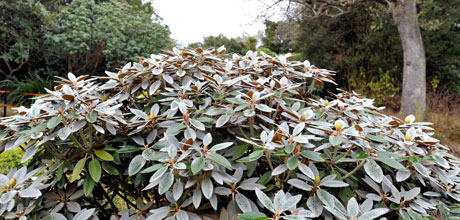Delicate Hairs Add to Beauty
This article was first published on 11 Jun 2012.

Pachysanthum
Looking at Rhododendron pachysanthum in the Rhododendron Dell peat garden at Dunedin Botanic Garden, it is easy to assume that there has been a hard frost. Even on warmer mornings though, the impression is the same, revealing that the frosted appearance is not caused by ice crystals but by hairs. These hairs grow so densely that they give the upper surface of the leaf a silvery colour.
Many rhododendrons have this moisture-conserving covering known as indumentum. However, Rhododendron pachysanthum is one of the most attractively indumented species. Whereas most rhododendrons with indumentum lose it from the top surface of the leaf within the first year, R. pachysanthum can hold onto it for up to 3 years. Varying in colour from tawny beige to silvery white, this hairy coating completely shrouds the new growth. It is at its most dense when the foliage is young, then gradually diminishes to a fine luminous layer as the season progresses. Meanwhile, the underside of the leaf behaves differently. Instead of thinning out, the hairs remain thick to retain moisture around the leaf pores and they deepen in colour from pinkish light brown to a rich rusty brown.
R. pachysanthum is one of the smaller rhododendrons, with a tight compact habit and eventually grows to about a metre high. So, a mature plant in full indumented splendour can be a captivating sight. In fact, the flowers, although beautiful, can inspire ambivalence when they appear because they leave gaps in the foliage when they fade.
Doug Thomson is curator of the Rhododendron Dell at Dunedin Botanic Garden.


